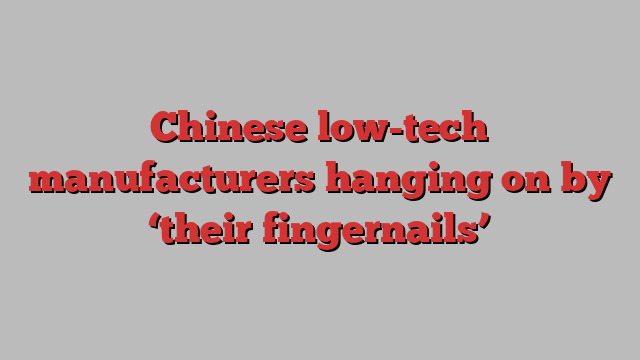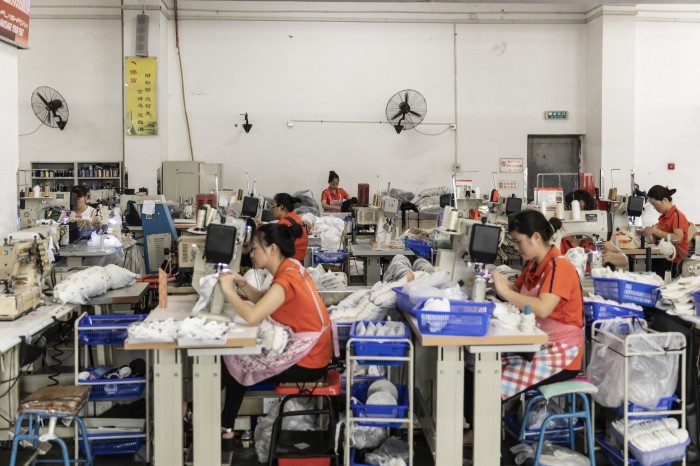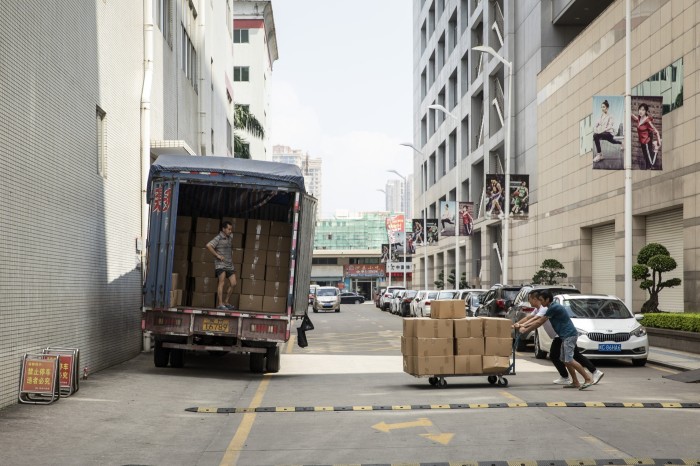
At a factory in China’s manufacturing heartland, workers manually add small splashes of paint or glitter to printed images of flowers — small tweaks designed to boost dwindling profits in the face of softer global demand.
“We would like to say that if you can go high-end, the better the quality of your paintings, the more classic they will be. But in the current global economy . . . the more we sell, the lower the price,” said Wang Xiaosha, general manager at Fujian Jie Ao Industrial in Minhou county in China’s south-eastern Fujian province.
While President Xi Jinping wants China’s economy to focus on “new quality productive forces” — such as green technology and electric vehicles — low-end factories have long been the backbone of the country’s explosive growth and one of the largest sources of jobs.
But these factories are increasingly struggling with anaemic orders from western buyers, trade restrictions in foreign markets and growing competition from rival hubs, particularly southeast Asian countries such as Vietnam and Indonesia, as well as Bangladesh and India.
The world’s largest exporter of apparel and a major producer of toys and furniture, “China remains the behemoth when it comes to labour-intensive goods”, said Fred Neumann, chief Asia economist at HSBC. But in the face of rising competition from lower-cost rivals, “these are all industries that are hanging on with their fingernails”.

Apparel, footwear and furniture accounted for 9 per cent of China’s exports in the first eight months of last year, according to a Bank of America Global Research report, down from 20 per cent in 2001. Car and machinery’s share of total exports increased to 33 per cent from 16 per cent over the same period.
China’s share of global footwear and apparel sales has slipped in recent years, with its portion of overall supply for brands Nike and Adidas falling from 20-27 per cent in 2017 to 16-20 per cent in 2022, according to the BofA report. While it remains the world’s largest supplier, China’s share of global footwear exports has declined by more than 10 percentage points over the past decade, according to figures from the 2023 World Footwear Yearbook.
Much of that capacity has shifted to south-east Asian countries, particularly Indonesia and Vietnam, the report added. Vietnam, now the world’s second-biggest exporter, has been the biggest beneficiary, with its share rising from 2 per cent to about 10 per cent.
The shift in part reflects companies’ search for lower labour costs but more recently the desire to de-risk supply chains amid rising geopolitical tensions. Any further retreat of traditional labour-intensive industries from China could lead to job losses, said HSBC’s Neumann, something which policymakers in Beijing are eager to avoid.
“Because the bulk of manufacturing in China is still medium- to low-end . . . you need these labour-intensive products factories to be there,” he said. “The frame of mind of policymakers is that it’s not just about dominating EVs or advanced technology or having your homegrown semiconductor industry. It’s also maintaining a productive capacity in all types of goods, even [the] lower end.”

Shoe and textile factories, ranging from plants 12 or more stories high to metal barnlike structures with steel roofs, line the streets of Jinjiang, an industrial city in Fujian. The city is home to giant shoemakers such as Anta as well as the world’s largest “one-stop” centre for sports footwear textiles.
Lai Mingquan, who runs Shenglong Microfibre, a wholesaler in the complex, said that while China’s high-tech EV push had created a source of demand for the synthetic leathers used in car interiors, weak overall domestic and foreign demand made it difficult for factories to adopt the latest technologies completely.
“As for automation, for a factory, it must reach a certain order volume,” he said. “But at present, some orders in China are not that large.”
Yang Xian’an, sales manager at BoBang, a suede microfibre manufacturer, said that while competition to produce newer and cheaper synthetic fabrics was constant and intense, new orders, particularly those from exporters shipping to foreign buyers, had declined since the end of the pandemic. “In this industry . . . every year is worse than the last,” he said.
While analysts said the country still dominated the supply of advanced fabrics used in footwear production, the wider manufacturing base for shoes, which was previously neatly concentrated in and around Jinjiang, has dispersed to other provinces and overseas, according to Zhang Xinglou, sales manager at Jia Yi Plastic Products, which makes components for shoes.
Falling external and domestic demand for shoes has hit companies such as his — which sell cheaper, unbranded products to factories — particularly hard, he said. The situation was worsened by tariffs imposed in markets such as the US against Chinese footwear, he added.
“High-tech is only one small part of the picture,” he said. “One factory produces so much in a day, and there are so many factories, everywhere there are factories. How can they support so many people?”
Back at Jie Ao Industrial, a sign hanging over the entrance of a warehouse reads: “Innovation is the root, quality is life.”
But with demand languishing and remaining customers focused on bargaining for lower prices, the company has had to slash its headcount of about 300 painters by half, said general manager Wang.
“For us traditional enterprises there are actually a lot of obstacles,” she said.